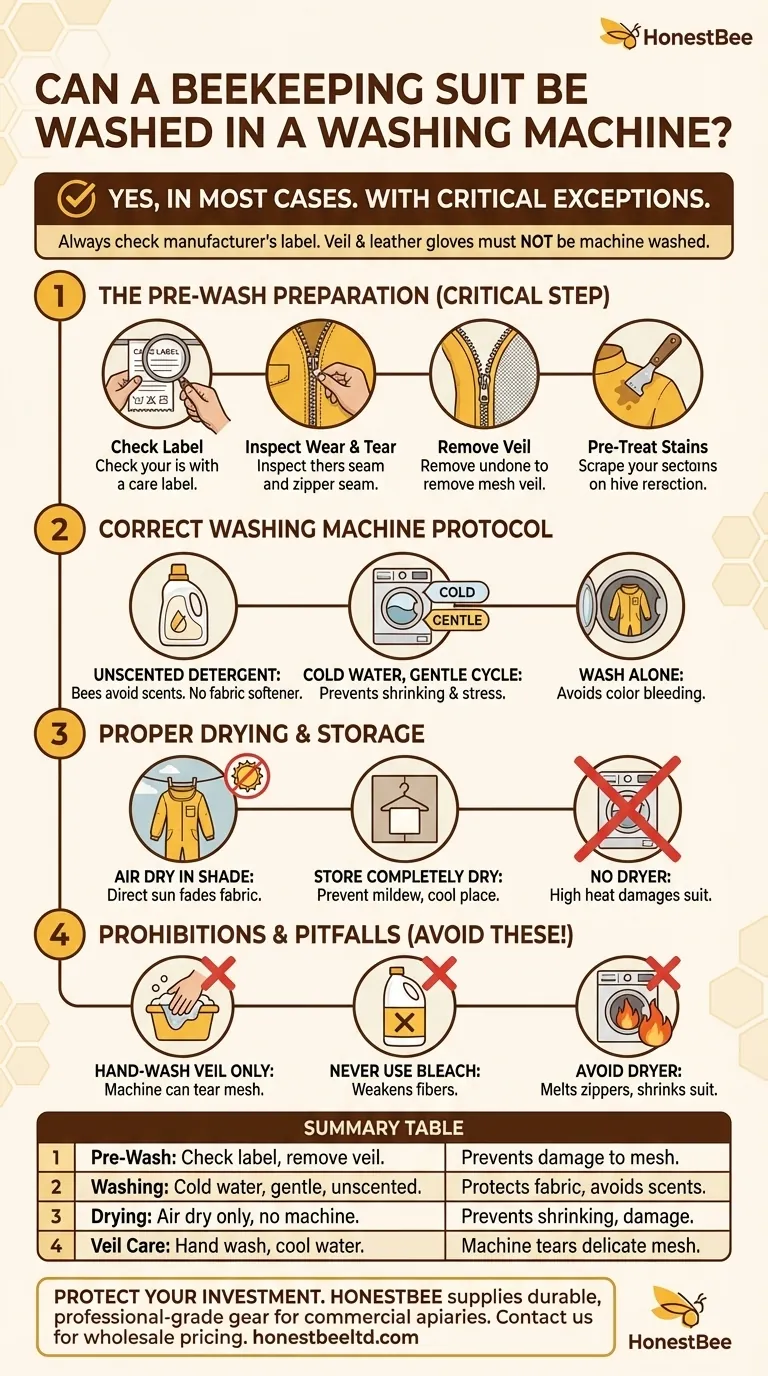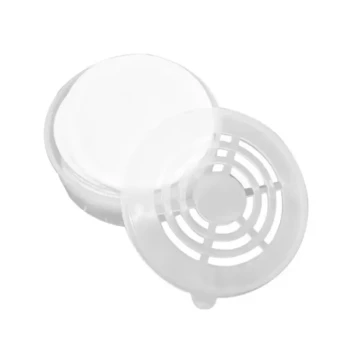Yes, in most cases, a beekeeping suit can be washed in a washing machine. However, this comes with critical exceptions. You must always check the manufacturer's care label first, and certain components, like the veil and leather gloves, should never be machine washed.
The goal is not simply to clean your suit but to do so without compromising its protective integrity or leaving behind scents that could agitate your bees. Proper care involves treating each part of your gear—the suit, the veil, and the gloves—according to its specific needs.

The Pre-Wash Preparation: A Critical First Step
Before your suit ever touches the water, a few preparatory steps are essential for both the suit's longevity and an effective clean.
Check the Manufacturer's Label
This is the single most important step. The care tag provides the definitive instructions for your specific suit's material and construction. Ignoring it can lead to shrinking or damage.
Inspect for Wear and Tear
Check all seams, zippers, and elastic bands for any rips or weak spots. A washing machine can exacerbate small holes, creating potential entry points for bees.
Remove All Detachable Parts
Unzip and remove the veil completely. The fine mesh of the veil is too delicate for a machine and can be easily torn or warped, compromising your protection. This is the most common and costly mistake.
Pre-Treat Stains
Use a hive tool to gently scrape off any large pieces of wax or propolis. For stains, apply a small amount of mild detergent directly to the spot before washing.
The Correct Washing Machine Protocol
Once the suit is prepped, using the right settings and supplies is key to a successful wash.
Choose an Unscented Detergent
Bees navigate and communicate using scent. Never use scented detergents or fabric softeners, as the lingering fragrances can cause agitation or defensive behavior from the colony. A mild, fragrance-free detergent is the only safe choice.
Select the Proper Cycle
Always use a cold water wash on the gentle or delicate cycle. Hot water can cause cotton suits to shrink, while a vigorous cycle can put unnecessary stress on the seams and zippers.
Wash the Suit by Itself
Washing your beekeeping suit alone prevents any potential color bleeding from other garments and ensures it has enough space to be cleaned thoroughly.
Understanding the Prohibitions and Pitfalls
Knowing what not to do is just as important as knowing what to do. These common mistakes can ruin your expensive gear.
Why You Must Hand-Wash the Veil
The veil's mesh is its most critical and fragile component. Machine washing can stretch, tear, or deform the mesh, obscuring your vision and creating dangerous gaps. Hand-wash the veil gently in cool water with a drop of mild soap, rinse thoroughly, and hang it to dry.
Never Use Bleach
Bleach will severely weaken the fabric fibers of your suit, drastically reducing its lifespan and protective capabilities.
Avoid the Dryer at All Costs
The high heat of a machine dryer is the fastest way to damage your suit. It will almost certainly cause shrinking, can melt plastic zippers, and degrades the integrity of the fabric.
Proper Drying and Storage
The Best Way to Dry Your Suit
After washing, hang your suit to air dry. For best results, hang it in a shady, well-ventilated area. Direct, intense sunlight can cause the fabric to fade and degrade over time.
Storing Your Clean Gear
Ensure the suit is completely dry before storing it to prevent mildew. Keep it in a cool, dry place away from direct sunlight and pests.
Making the Right Choice for Your Gear
- If your primary focus is safety and longevity: Always separate the suit, veil, and gloves, washing each component individually by the most appropriate method—machine for the suit, hand for the veil.
- If your primary focus is convenience for a lightly soiled suit: You can use a gentle, cold machine cycle for the suit only, after confirming the care label allows it and you have removed the veil.
- If you are dealing with heavy propolis or stains: Scrape off as much as possible and pre-treat the stains before any washing method to ensure they are fully removed.
Properly maintaining your suit is a fundamental practice that ensures your safety and the well-being of your bees.
Summary Table:
| Step | Key Action | Why It's Important |
|---|---|---|
| Pre-Wash | Check the label & remove the veil. | Prevents damage to delicate mesh and ensures you follow manufacturer guidelines. |
| Washing | Use cold water, gentle cycle, and unscented detergent. | Protects fabric from shrinking and avoids agitating scents that upset bees. |
| Drying | Always air dry; never use a machine dryer. | High heat causes shrinking and damages zippers and fabric integrity. |
| Veil Care | Hand wash only in cool water. | Machine washing can tear or warp the critical protective mesh. |
Protect your investment and ensure your safety with professional-grade beekeeping supplies from HONESTBEE. We supply durable suits, veils, and equipment designed for the rigorous demands of commercial apiaries and distributors. Our wholesale-focused operations mean you get reliable gear that stands up to proper cleaning and heavy use. Let us help you equip your operation with gear that lasts. Contact HONESTBEE today for wholesale pricing and expert advice.
Visual Guide

Related Products
- Wholesales Dadant Size Wooden Bee Hives for Beekeeping
- Professional Insulated Plastic Bee Hives
- Long Langstroth Style Horizontal Top Bar Hive for Wholesale
- Automatic Honey Flow Beehive 4 Frame Mini Hive for Beekeeping
- Professional Insulated Winter Hive Wrap for Beekeeping
People Also Ask
- What types of products are available for beekeeping needs? Essential Equipment for Apiaries & Distributors
- What is the best place to keep bees? Find the Perfect Apiary Site for Your Hives
- What are the advantages of wooden bee hives? Superior Bee Health & Beekeeper Flexibility
- What is beekeeping equipment? Essential Tools for Commercial Apiaries & Distributors
- What are the characteristics of oil-based paint for beehives? Durability vs. Modern Practicality



















